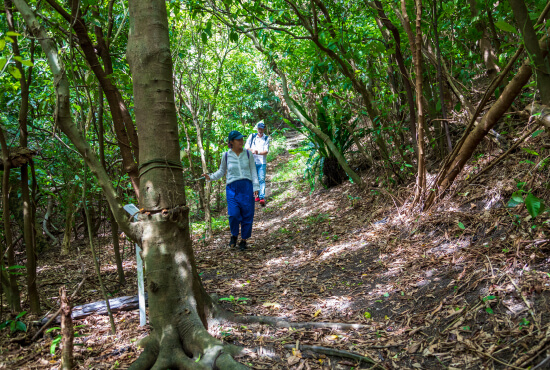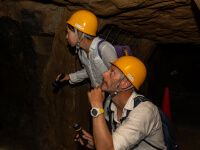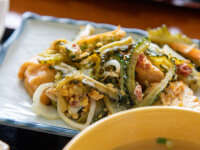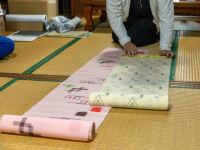At the end of World War II, Okinawa became the battlefield involving the local people, and many Okinawans lost their lives. During the war, a student corps consisting of teenagers was formed, and you will visit the army hospital bunker where the girls actually worked, and experience what it was like in those days. Afterwards, you will walk through the villages near the bunker and learn how the Okinawan people are recovering from the war. Throughout the tour, you will be able to see the transition from the Battle of Okinawa to the way people live today.
●The Battle of Okinawa and the path to carry meals for soldiers
The path to carry meals for soldiers in the hospital bunkers is one of the few remaining paths in Okinawa. Today the path is overgrown with trees, but at that time there was only short grass growing on it. The sounds of fighter jets flying overhead, some smells carried by the wind, and the humidity weather, the Himeyuri student corps helped each other and risked their lives as they ran along this path to deliver food to the banker. Let's sharpen all our five senses and walk along this path, imagining what it was like to help each other and connect with people during the war.
●Bunker Passage Experience
You can get a glimpse of what it was like during the Battle of Okinawa through the experience of walking through a bunker that was used as an army hospital by the Japanese Army. The bunker is not only dark and cramped, but also very humidity throughout the year. Wounded soldiers were brought into these bunker, and military doctors, nurses, medics, and Himeyuri students provided medical care for about two months. Imagine the smells and darkness in the bunker at that time and relive the experience.
*Because there is no lighting inside the bunker, please use the flashlight provided at the entrance and wear a helmet for your own safety.
●Lunch
During the war, the daily meal was one small rice ball. During the postwar reconstruction period, meals were coarse, but they were traditional home cooking using island vegetables, the secret to a long and healthy life. Through home cooking using Okinawan ingredients at a local diner, you will experience the transition from wartime to postwar and to the present day.
●Street of Ryukyu Kasuri
♪Sharatonton~, Sharatonton~. Walking around Motobu, Teruya, and Kyan areas of Haebaru Town, one can hear a pleasant sound coming from somewhere. The sound of weaving has always been a part of life in Haebaru, sometimes as a lullaby, sometimes as a life lesson, and sometimes as a noisy sound. During the postwar reconstruction period, people gathered all kinds of materials and worked hard to produce textiles again, and their weaving skills supported their impoverished lifestyles. Ryukyu Kasuri, a traditional Okinawan woven textile, has been passed down from parents to children and grandchildren over the ages, helping each other and cherishing the "connection" between people, while the gentle texture and high-quality weaving techniques have been handed down with the cherished thoughts of our predecessors. This tour will take you on a walking tour of an area where the tradition of "Karuri," one of the industries that supported postwar reconstruction, still remains.
【 Notes on reservation 】
●The entire tour (about 6 km) will be on foot, so please wear comfortable clothing and walking shoes. Please wear sunscreen, sunglasses, and a hat to protect yourself from heat stroke and sunburn, and bring drinking water.
●Please note that wheelchairs and strollers are not accessible on the road to the path to carry meals for soldiers.
●The Okinawa Army Hospital Haebaru Bunker No.20 is designated as a cultural asset by Haebaru Town. For the protection of cultural assets, please follow the guide's instructions while in the bunker.
●If you have any food allergies or restriction, please contact with us.
●The price vary depending on the number of participants and other factors.
●Please contact with us if you wish to join the tour with more than 8 people.
●Please note that the itinerary may be changed or cancelled depending on the season, weather, or other factors.
●Please contact us if you would like a different start time for the tour. Please note that the tour content may change depending on the start time.
●Please be aware that temperatures and humidity are expected to be extremely high during the summer season. Please take precautions against sunburn and heat stroke by yourself. If you do not feel well during the tour, please do not hesitate to ask our staff for assistance.
●During the summer, the activity level will be 2 due to the increase in temperature and humidity.







